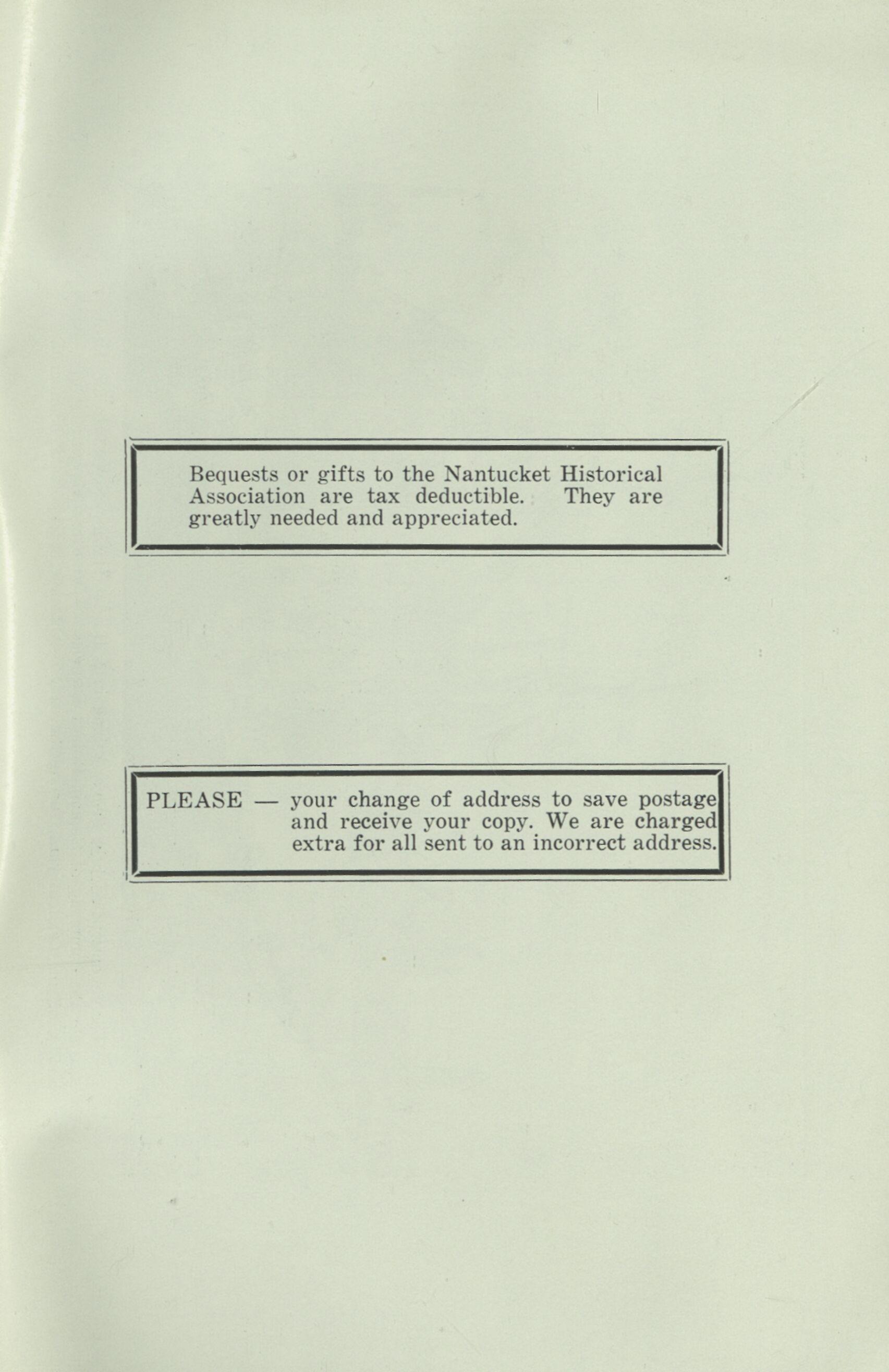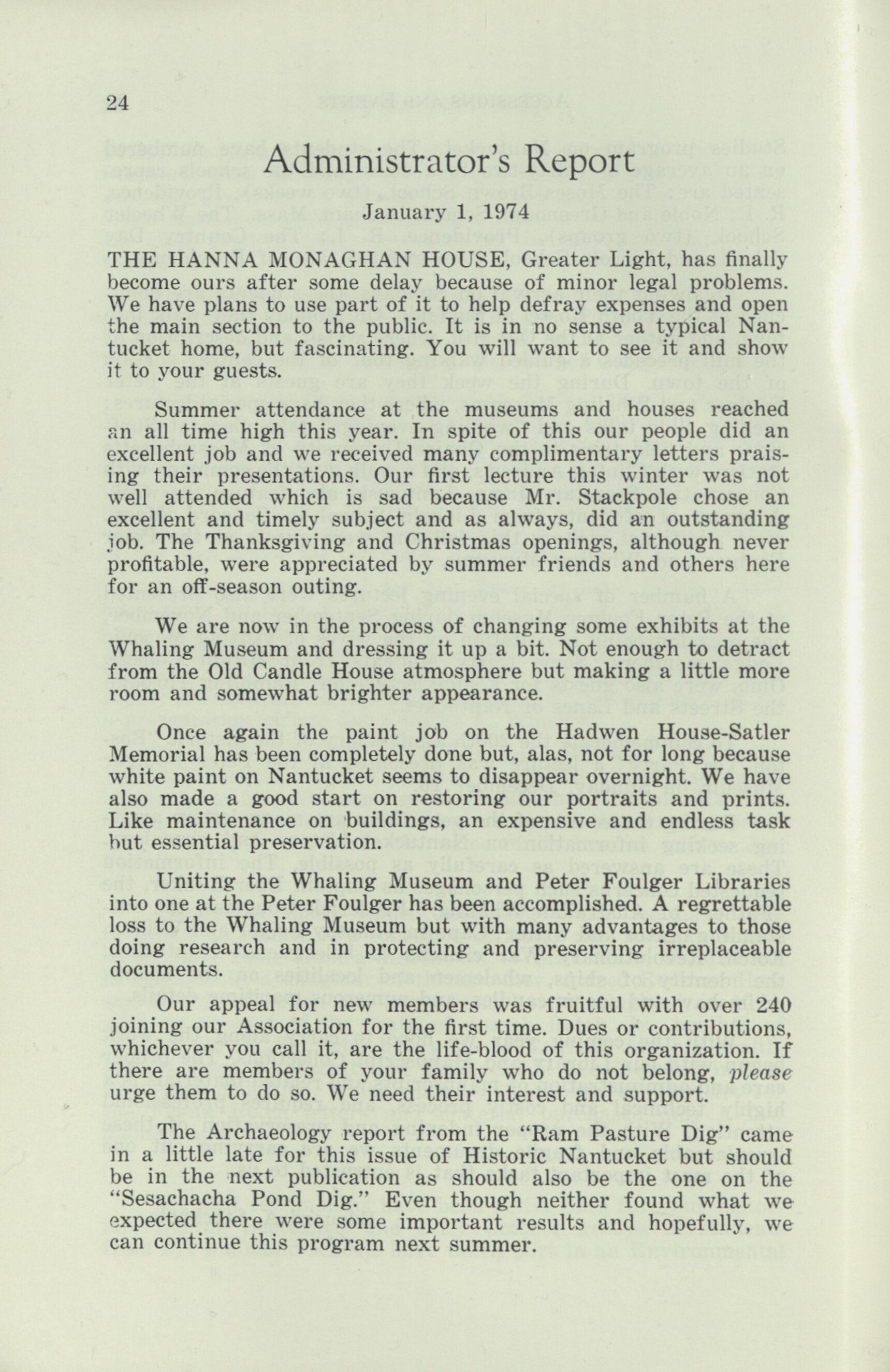
12 minute read
Administrator's Report
24
January 1, 1974
THE HANNA MONAGHAN HOUSE, Greater Light, has finally become ours after some delay because of minor legal problems. We have plans to use part of it to help defray expenses and open the main section to the public. It is in no sense a typical Nantucket home, but fascinating. You will want to see it and show it to your guests.
Summer attendance at the museums and houses reached an all time high this year. In spite of this our people did an excellent job and we received many complimentary letters praising their presentations. Our first lecture this winter was not well attended which is sad because Mr. Stackpole chose an excellent and timely subject and as always, did an outstanding job. The Thanksgiving and Christmas openings, although never profitable, were appreciated by summer friends and others here for an off-season outing.
We are now in the process of changing some exhibits at the Whaling Museum and dressing it up a bit. Not enough to detract from the Old Candle House atmosphere but making a little more room and somewhat brighter appearance.
Once again the paint job on the Hadwen House-Satler Memorial has been completely done but, alas, not for long because white paint on Nantucket seems to disappear overnight. We have also made a good start on restoring our portraits and prints. Like maintenance on buildings, an expensive and endless task but essential preservation.
Uniting the Whaling Museum and Peter Foulger Libraries into one at the Peter Foulger has been accomplished. A regrettable loss to the Whaling Museum but with many advantages to those doing research and in protecting and preserving irreplaceable documents.
Our appeal for new members was fruitful with over 240 joining our Association for the first time. Dues or contributions, whichever you call it, are the life-blood of this organization. If there are members of your family who do not belong, please urge them to do so. We need their interest and support.
The Archaeology report from the "Ram Pasture Dig" came in a little late for this issue of Historic Nantucket but should be in the next publication as should also be the one on the "Sesachacha Pond Dig." Even though neither found what we expected there were some important results and hopefully, we can continue this program next summer.
ADMINISTRATOR'S REPORT 25
The Board of Selectmen has asked us to take the leadership in the Bi-Centennial Celebration and we are now formulating plans. The success of this will depend greatly upon the number who volunteer to help and the effort they make to put across a constructive and meaningful program.
The prints we loaned were well received at the Heritage Plantation of Sandwich for their outstanding Currier and Ives exhibit and, strangely enough, the number one choice of the exhibit was "Husking," an Eastman Johnson, painted here on Nantucket. Our prints are now back in the Whaling Museum. You may want to take a new look at them and at the picture in the Peter Foulger, another famous Eastman Johnson, painted on Nantucket, which recently sold for a fabulous price. And while you are there, glance at the 1974 on Walter Folger's clock. It glided into the new year as this genius intended it to do when he built it by hand 183 years ago.
Leroy H. True
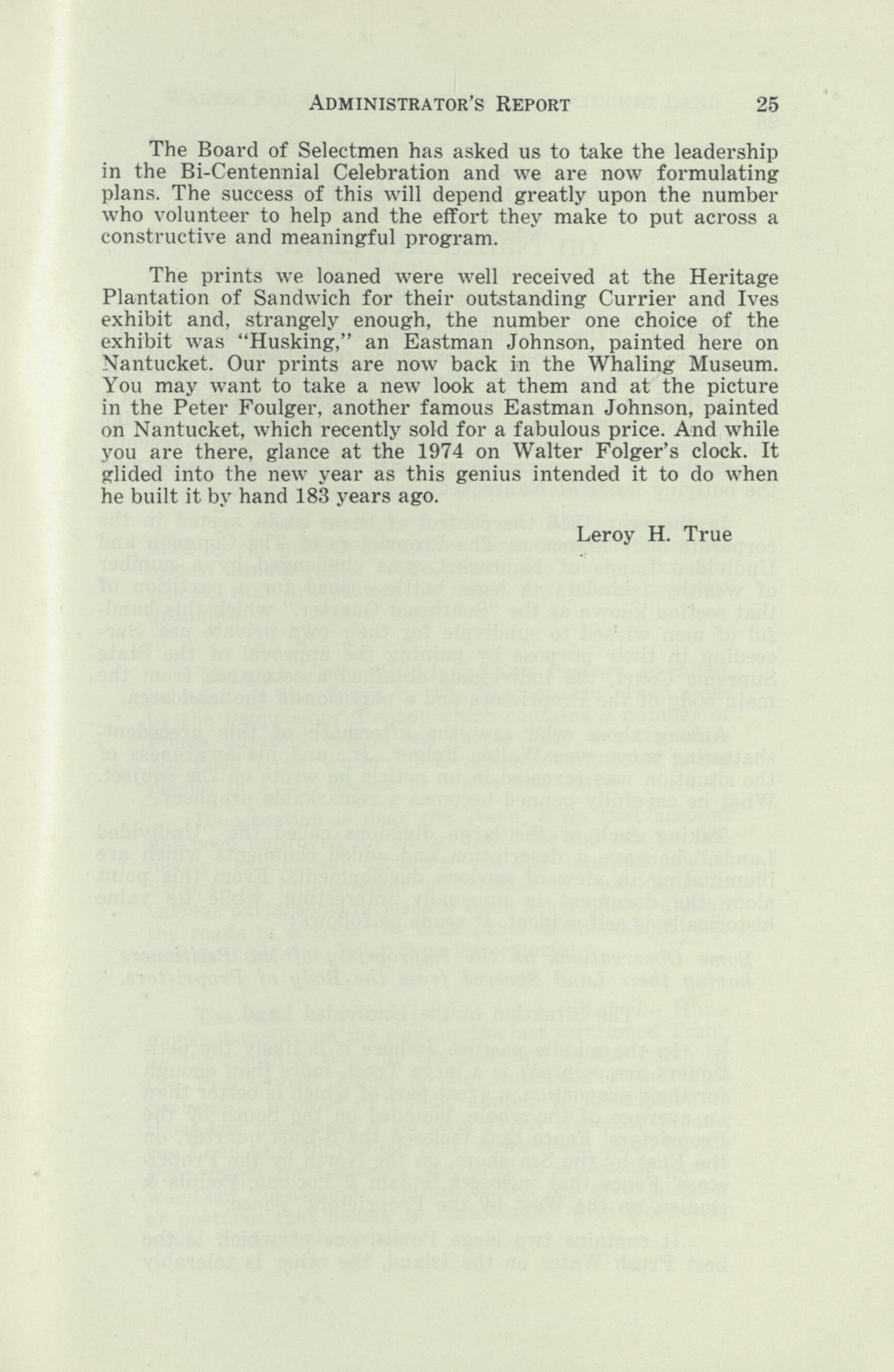
26
Walter Folger, Jr.'s Prophecy on Nantucket Land
BY EDOUARD A. STACKPOLE
THE FAME of the Nantucket genius, Walter Folger, Jr., would rest secure with the preservation of his remarkable astronomical clock, now exhibited at the Peter Foulger Museum of the Nantucket Historical Association. But this versatile Islander was a man of many parts — a surveyor, teacher, lawyer, mathematician and inventor. And another of his talents has been only recently recognized — his extraordinary gift of prophecy concerning the outlying lands of Nantucket.
In the year 1816 the control of these lands, vested in the corporate body known as The Proprietors of The Common and Undivided Lands of Nantucket, was challenged by a number of wealthy Islanders. A legal battle ensued for a partition of that section known as the "Southeast Quarter," which this handful of men wished to subdivide for their own private use. Succeeding in their purpose by gaining the approval of the State Supreme Court, the individuals obtained a severance from the main body of the Proprietors and a partition of the land area.
Among those who saw the aftermath of this precedentshattering move was Walter Folger, Jr., and his awareness of the situation was revealed in an article he wrote on the subject. What he carefully penned becomes a remarkable prophecy.
Taking each of the large divisions called the "Undivided Lands," he gave a description and added comments which are illuminating in view of modern developments. From this point alone the document is unusually interesting, while its value historically is self-evident. It reads as follows:
Some Observations on the Impropriety of the Petitioners having their Land Severed from the Body of Proprietors. The Situation of the Undivided Land. In the middle pasture (where it is likely the petitioners are pointed) is a large Tract, more than enough for their proportion, a great part of which is better than an average of the whole, bounded on the South by the
Proprietors' Fence that inclosed the S-East quarter, on the East by the Sea shore, on the North by the Proprietors' Fence that incloseth Squam & Pocomo, Podpis &
Quaise, on the West by the Proprietors' Fence. It contains two large Ponds, one of which is the best Fresh Water on the Island, the other is tolerably
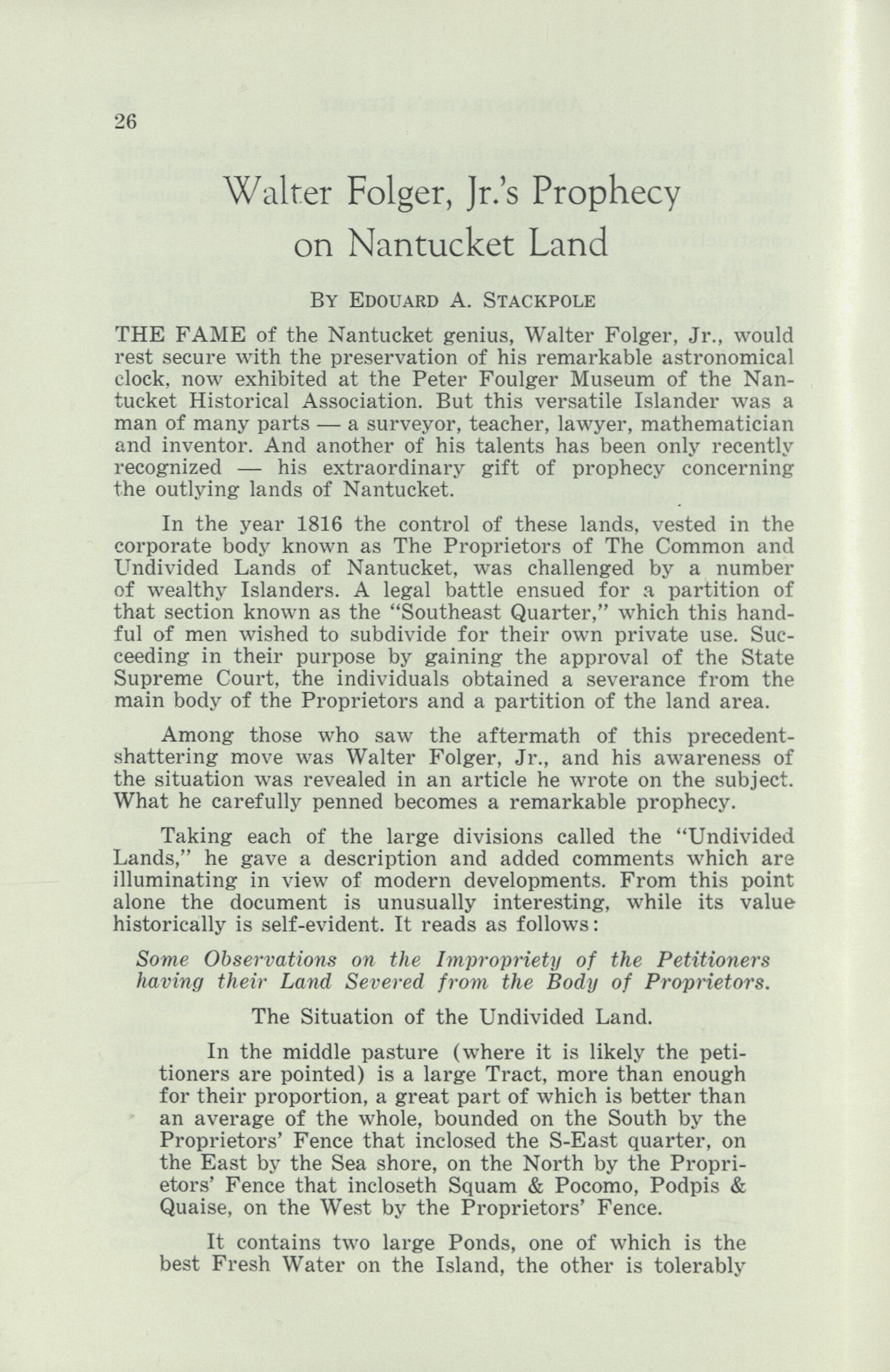
good for Cattle & Horses; and many large swamps, bedded with a superabundance of that kind of mud called Peat, and is considered valuable to the Proprietors, considering the situation of the Island, surrounded by the Sea, & no Trees of natural growth.
As the swamps now lie in common, Proprietors and non-Proprietors have free access to them, without any expense or molestation, from which a great number of Families are supplied with their Firing in Peat and brush; particularly all the Inhabitants of the village of Podpis, & the poor Fishermen, that through necessity are obliged, at certain seasons of the year, to Fish in Boats from the East end of the Island, besides many poor inhabitants in the Town, who derive great benefit from the unmolested privilege of bringing to their families in Winter abundance of Brush for Firing.
The roads through this Tract, which have been used by the publick ever since the memory of Man, are almost innumerable. Also, there are many watering places, that are seldom or never dry in the greatest droughts.
• * * *
The next to be noticed is the Cow Pasture, so called, bounded on the South by the Sea, on the other sides by the Proprietors' Fence; which contains a number of Ponds adjacent to the sea shore. They are therefore not good fresh Water; it is nearly destitute of other places, in a dry season, to Water the Cattle.
Its situation is near the Town, & on that account has been improved for tillage until the soil has become nearly exhausted, destitute of any unappropriated Swamps, & impregnated with Lands of individuals in various parts, some inclosed & some not inclosed; and all the roads to & from the East parts of the Island; has run through this Tract time immemorial.

The next in course is that tract called the Hummocks bounded on the East by the last mentioned Tract, on the South & West by the Sea, and on the north by the Proprietors' Fence & the Hummock Pond. This contains a number of Ponds, similar in description to those last mentioned & no good Fresh Watering places; the Land of a thin Weak Soil; & has been tilled by the Proprietors for Common, etc, until it is become neaily worn out. No swamps unappropriated, & a gieat numbei of pastures that belong to Individuals; with Necessary roads through the whole.
28
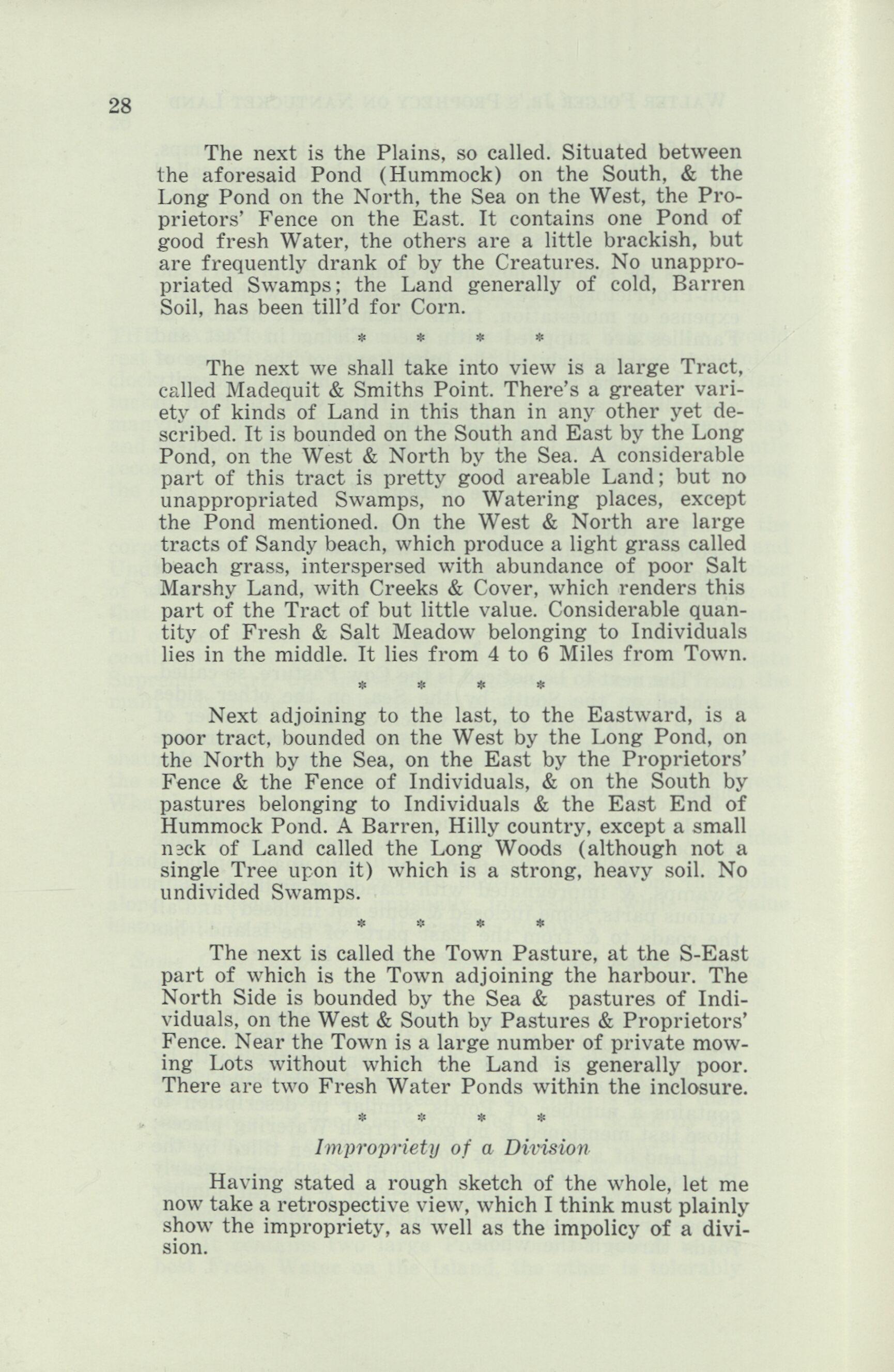
The next is the Plains, so called. Situated between the aforesaid Pond (Hummock) on the South, & the Long Pond on the North, the Sea on the West, the Proprietors' Fence on the East. It contains one Pond of good fresh Water, the others are a little brackish, but are frequently drank of by the Creatures. No unappropriated Swamps; the Land generally of cold, Barren Soil, has been till'd for Corn.
H5 H*
3s
%
The next we shall take into view is a large Tract, called Madequit & Smiths Point. There's a greater variety of kinds of Land in this than in any other yet described. It is bounded on the South and East by the Long Pond, on the West & North by the Sea. A considerable part of this tract is pretty good areable Land; but no unappropriated Swamps, no Watering places, except the Pond mentioned. On the West & North are large tracts of Sandy beach, which produce a light grass called beach grass, interspersed with abundance of poor Salt Marshy Land, with Creeks & Cover, which renders this part of the Tract of but little value. Considerable quantity of Fresh & Salt Meadow belonging to Individuals lies in the middle. It lies from 4 to 6 Miles from Town. $ $ $ $
Next adjoining to the last, to the Eastward, is a poor tract, bounded on the West by the Long Pond, on the North by the Sea, on the East by the Proprietors' Fence & the Fence of Individuals, & on the South by pastures belonging to Individuals & the East End of Hummock Pond. A Barren, Hilly country, except a small neck of Land called the Long Woods (although not a single Tree upon it) which is a strong, heavy soil. No undivided Swamps. • • • •
The next is called the Town Pasture, at the S-East part of which is the Town adjoining the harbour. The North Side is bounded by the Sea & pastures of Individuals, on the West & South by Pastures & Proprietors' Fence. Near the Town is a large number of private mowing Lots without which the Land is generally poor. There are two Fresh Water Ponds within the inclosure.
• • • H*
Impropriety of a Division
Having stated a rough sketch of the whole, let me now take a retrospective view, which I think must plainly show the impropriety, as well as the impolicy of a division.
Within the inclosure called the S. East quarter, although laid out for Land of Inheritance, there is a large Tract of Sandy Beach called Low Beach, & many other small places, around the edges of P. tract, belonging to the Proprietors in common & not laid out with the next.
Within the inclosure called Squam & Pocomo, there is the Great Point & Coatue Point, which are several Miles in length, & little else than Beach Plum Bushes, Beach Grass, & a few Scrub Cedars grown upon them, which is undivided Land & also within the Proprietors' inclosure there is a large tract of Salt Meadow, laid out for Land of Inheritance long before the general division of Squam & Pocomo, around the margin of which there are two rods of upland assigned (not laid out) for the benefit of the owners of the Meadow to spread their Hay upon (which is the case throughout the Island where there is Salt Meadow laid out) & many other small tracts of upland within the Proprietors' inclosure, all of which is undivided Land; besides Roads convenient to pass and repass through the Proprietors' Tract, which have been used by the publick since time immemorial, the principal one of which is now inclosed from the publick by one of the Petitioners, & all privileges of passing is wholly denied; the same road, or another part of it, is also stopped by another of the Petitioners, but he is kind enough to provide gates, but at the same time has got inclosed a considerable quantity of the Proprietors' Land & refuseth to fence it out!
We will next consider Brant Point, Eel Point, Smiths Point, & the Beach parts of Smooth Hummocks, which are sandy points of Beach, on which nothing grows of much consequence.
The whole of the above mentioned divisions comprises thousands of acres of Land of not much value, yet, nevertheless, in a division would count according to quantity.

Proprietors Had an Early Grant
Another thing may be considered. There was an early grant of the Proprietors for their own convenience, for each Share to have the Privilege of taking up where it suited them best; 46 Acres to a Share, agreeable to which they picked their spots, at any part of the Island, where it did not interfere with publick or private, but was generally chosen within two miles of the Town, which of course would leave the Land not taken up, where these Lots are, very poor.
HISTORIC NANTUCKET
Further Division Would Destroy The Patents Which Governed Lands
Now taking a Comprehensive view of the whole. If the present Petition obtains, it will destroy the Patents & with it all rules & regulations that so long have preserved us in peace. Others would then take the same courses & by the right & so on, to as many as wanted their Land by themselves.
I now would ask which or whether any of them would be willing or expect to take their proportion in all the different tracts above described, which in fact they want their proportion of, or whether they expect to have their part, set off in a nice good spot, separated from all those embarrassing circumstances above related.
Suppose the latter. What is to become of those that are left to take the last? Of course, it must be the poorer class, because the weakest goes by the wall. When in the way they are now in, they are as Independent as the great Owners. But, alas, these all would be Lost.
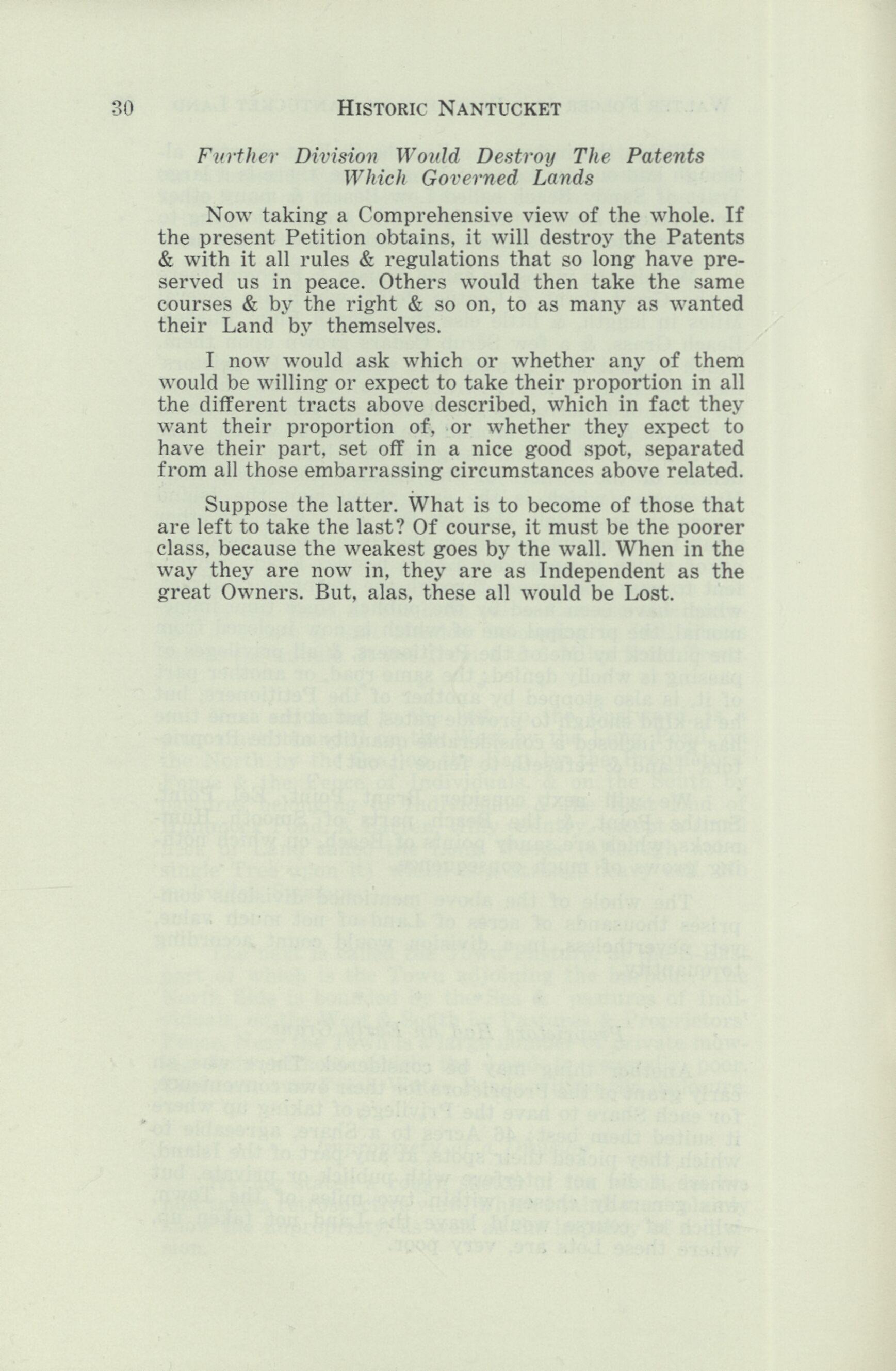
Bequests or gifts to the Nantucket Historical Association are tax deductible. They are greatly needed and appreciated.
